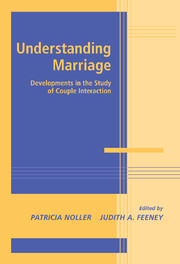Book contents
- Frontmatter
- Contents
- Contribitors
- Introduction
- SECTION ONE THE EFFECT OF COGNITION ON INTERACTION PATTERNS
- SECTION TWO UNDERSTANDING THE IMPORTANCE OF POSITIVE INTERACTION
- SECTION THREE COPING WITH DISAPPOINTMENT, CRITICISM, AND BETRAYAL
- SECTION FOUR POWER, CONFLICT, AND VIOLENCE IN MARITAL INTERACTION
- Marital interaction at important transition periods
- SECTION SIX Interventions for strengthening relationships
- Conclusions
- Index
- References
Conclusions
Published online by Cambridge University Press: 25 July 2009
- Frontmatter
- Contents
- Contribitors
- Introduction
- SECTION ONE THE EFFECT OF COGNITION ON INTERACTION PATTERNS
- SECTION TWO UNDERSTANDING THE IMPORTANCE OF POSITIVE INTERACTION
- SECTION THREE COPING WITH DISAPPOINTMENT, CRITICISM, AND BETRAYAL
- SECTION FOUR POWER, CONFLICT, AND VIOLENCE IN MARITAL INTERACTION
- Marital interaction at important transition periods
- SECTION SIX Interventions for strengthening relationships
- Conclusions
- Index
- References
Summary
Like fingerprints, all marriages are different.
—G. B. ShawThe study of marriage has advanced significantly over the last two decades, with new theories and methodologies coming to the fore. In this book, we have assembled some of the most innovative and creative work in this area, and the studies represent a broad sample of the latest research. The contributions shed new light on the characteristics of couples' day-to-day interactions, together with their attempts to negotiate major problems and transitions.
THEORETICAL PERSPECTIVES
The studies of marriage presented in this book come from a range of theoretical perspectives. This theoretical underpinning is a major strength, allowing researchers and clinicians to develop and test specific predictions about the nature of interaction processes and their effects on marital outcomes.
Attachment Theory
Attachment theory provides a guiding framework for the research by Simpson and his colleagues, and is also discussed in a number of other chapters. This theory highlights the importance of the bond between marital partners and the implications of earlier relationship experiences for the success of their couple relationships. This focus on intimate relationships as attachment relationships comes from the work of Hazan and Shaver (1987), who explored the relevance of attachment history and attachment security to adult romantic love. According to this perspective, attachment behavior is a normal part of romantic involvements, and these relationships play a central role in meeting partners' needs for comfort and security.
- Type
- Chapter
- Information
- Understanding MarriageDevelopments in the Study of Couple Interaction, pp. 519 - 534Publisher: Cambridge University PressPrint publication year: 2002

